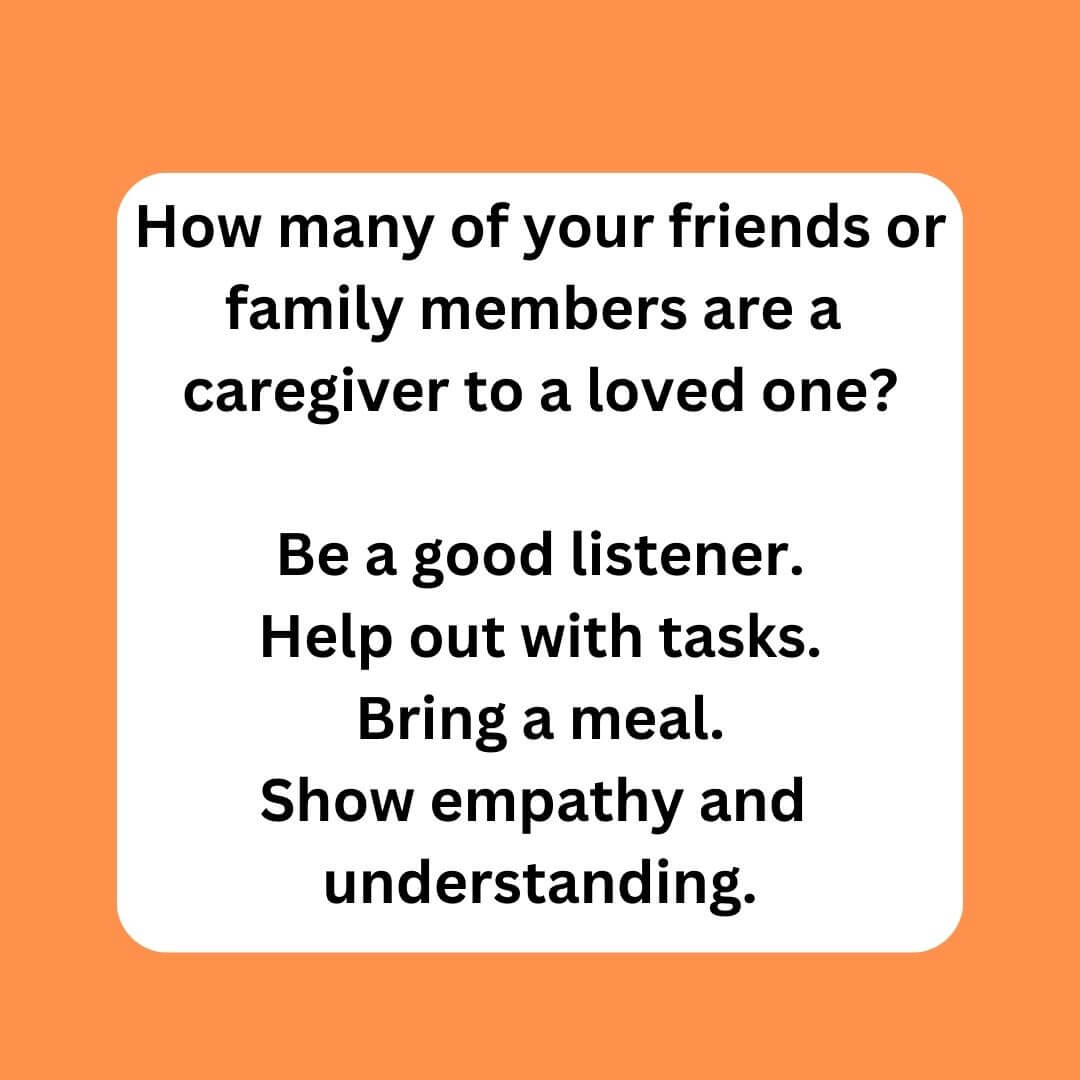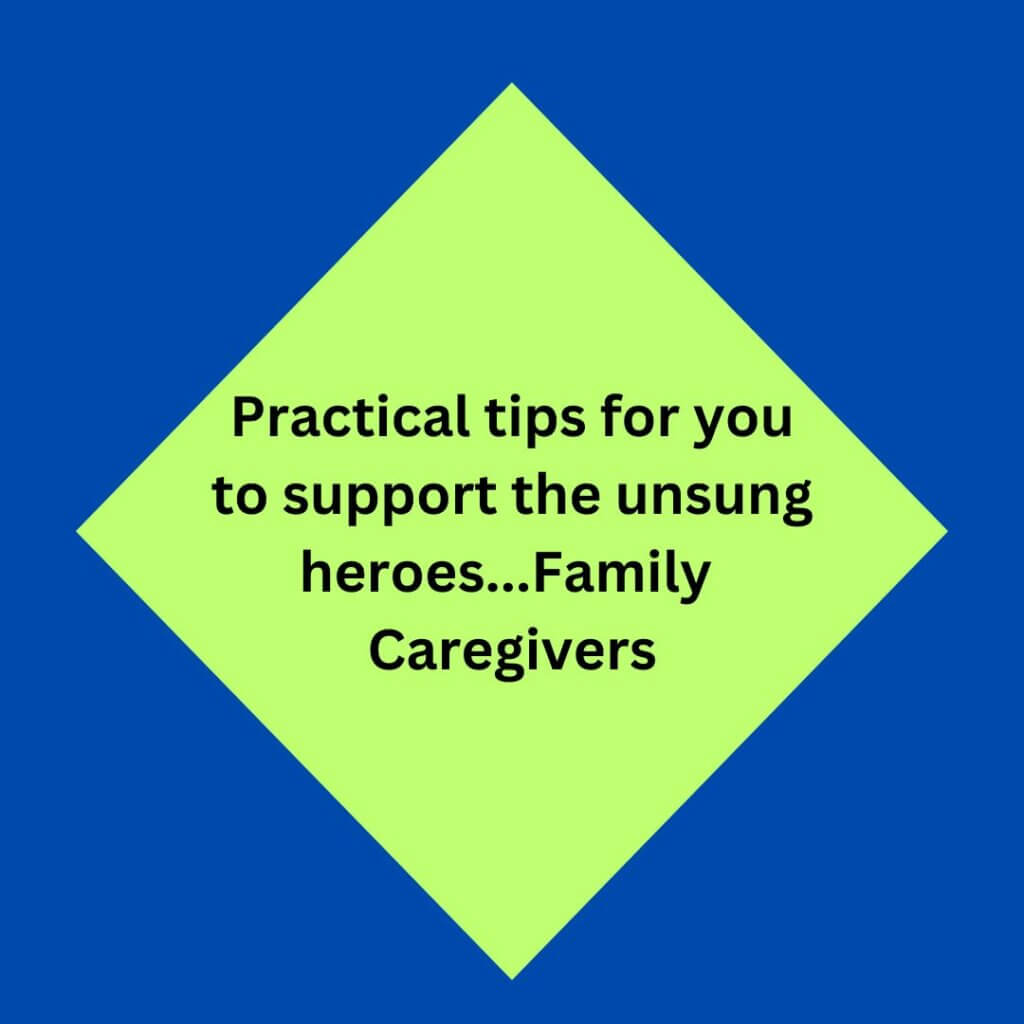
Primary family caregivers are the unsung heroes of our society. They are the ones who provide care, love, and support to their loved ones who are ill, disabled, or elderly. Being a primary family caregiver is a challenging role that requires a lot of physical and emotional energy. The responsibilities of a caregiver can be overwhelming, and often they may feel isolated and unsupported. This is where family and friends come in. In this post, we will explore how family and friends can assist primary family caregivers. We will discuss practical ways that you can support and help caregivers, including offering respite care, providing emotional support, and connecting them with resources. By supporting primary family caregivers, we can help lighten the load and show them that they are not alone in their journey.
1. Introduction: Understanding the role of primary family caregivers
Introduction: Understanding the role of primary family caregivers because some of you have no clue what a family caregiver does or goes through.
Primary family caregivers play a vital role in the lives of their loved ones who require care and support. The dedication and selflessness of primary family caregivers are unparalleled, as they navigate the challenges and demands of caregiving while juggling their own personal and professional lives.
The role of a primary family caregiver goes far beyond just assisting with daily tasks. They become the pillars of strength, advocates, and sources of comfort for their loved ones. They provide companionship, manage medications, coordinate medical appointments, handle household chores, and offer emotional support during difficult times. The responsibilities can be overwhelming, leading to stress, burnout, and even neglect of their own well-being.
2. The challenges faced by primary family caregivers
Being a primary family caregiver is not an easy task. It comes with a multitude of challenges that can often be overwhelming. These unsung heroes take on the responsibility of caring for a loved one, whether it be an aging parent, a disabled sibling, or a child with special needs.
One of the most significant challenges faced by primary family caregivers is the physical and emotional toll it can take on them. They often find themselves juggling multiple roles and responsibilities, from managing medications and doctor’s appointments to providing personal care and emotional support. This constant demand for their time and energy can lead to exhaustion, burnout, and even feelings of isolation, frustration, and anger.
Financial strain is another common challenge faced by primary family caregivers. The costs associated with caregiving, such as medical expenses, specialized equipment, and home modifications, can quickly add up. Many caregivers find themselves sacrificing their own financial stability and career advancement to prioritize the needs of their loved ones.
In addition to these challenges, primary family caregivers often face a lack of support and understanding from society. Caregiving can be a lonely journey, as friends and acquaintances may not fully comprehend the daily struggles and sacrifices involved. This can lead to feelings of isolation and a sense of being undervalued.
It is crucial for family and friends to recognize and understand these challenges. By offering support and assistance to primary family caregivers, we can alleviate some of the burdens they face. This can be as simple as offering a listening ear, providing respite care to give them a break, or helping with errands and household tasks. Even doing some of the tasks and chores at the caregiver’s house.

3. The importance of support from family and friends
When it comes to caregiving, the importance of support from family and friends cannot be overstated. Primary family caregivers shoulder a significant amount of responsibility and often face physical, emotional, and mental exhaustion. This is where the support system of family and friends plays a crucial role.
The support of loved ones provides much-needed respite for the primary family caregiver. Taking care of a loved one can be a 24/7 commitment, leaving little time for self-care or personal pursuits. Family and friends can step in to offer temporary relief, allowing the caregiver to take a break, recharge, and attend to their own needs. This support not only prevents burnout but also ensures that the caregiver can continue providing quality care for their loved one in the long run. Two or three hours will help.
Additionally, emotional support is invaluable for primary family caregivers. The challenges and stresses of caregiving can often feel overwhelming. Having someone to talk to, share concerns with, and lean on during difficult times can provide immense comfort and reassurance. Family and friends can offer a listening ear, a shoulder to cry on, or simply a comforting presence, reminding the caregiver that they are not alone in this journey. Let that be active listening and understanding with empathy. Do not tell them what to do or not to do, just listen. If you think the words. “should” or “I would” then keep your mouth shut.
Practical assistance from family and friends can significantly lighten the caregiver’s load. Whether it’s helping with household chores, running errands, or providing transportation, these small acts of kindness can make a world of difference. By sharing the responsibilities, family and friends can alleviate some of the physical strain on the primary caregiver, giving them more time to focus on their loved one’s care.
The involvement of family and friends in the caregiving process can strengthen the bond between them and the primary caregiver. It fosters a sense of unity and shared responsibility, creating a support network that can sustain the caregiver in their challenging role. It also allows others to gain a deeper understanding of the caregiver’s experiences and the needs of their loved one, fostering empathy and compassion within the family and friend circle.
4. Practical ways to support primary family caregivers
1. Offer respite care: Arrange to take over caregiving duties for a few hours or even a day to give the primary caregiver a much-needed break. This will allow them to recharge and take care of their own needs.
2. Provide meal assistance: Preparing meals can be time-consuming for caregivers. Offer to cook meals or organize a meal train where friends and family can take turns providing nutritious and homemade meals for the caregiver and their family.
3. Help with household tasks: Everyday tasks like cleaning, laundry, and grocery shopping can become overwhelming for primary caregivers. Offer to help with these chores or hire professional services to lighten their load at the caree’s place or the carer’s place.
4. Be a good listener: Sometimes, caregivers simply need someone to talk to and share their feelings and frustrations. Be a supportive listener without judgment and provide a safe space for them to express their emotions.
5. Offer transportation assistance: Taking the care recipient to medical appointments or running errands can be time-consuming and exhausting. Offer to provide transportation whenever possible, relieving the caregiver of this responsibility.
6. Research resources: Take the initiative to research and gather information on support groups, respite care facilities, or other resources that may benefit the caregiver. Present them with options and assist in making necessary arrangements.
7. Show appreciation: Express your gratitude and appreciation for the caregiver’s selfless dedication. A simple thank you, a heartfelt note, or a small token of appreciation can go a long way in boosting their spirits and acknowledging their hard work.
a. Offering respite care
Being a primary family caregiver can be an overwhelming and demanding role. It requires constant attention, patience, and selflessness to care for a loved one who may be facing physical or mental health challenges. As much as primary family caregivers may be devoted to their role, it’s essential to recognize that they also need time to recharge and take care of their own well-being.
This is where offering respite care becomes crucial in supporting the unsung heroes of caregiving. Respite care involves providing temporary relief to primary family caregivers by taking over their responsibilities for a short period. It allows caregivers to take a much-needed break, attend to personal matters, or simply have some time for themselves. You may only have to sit with them or be there in case the caree needs a little help.
Respite care can be provided by other family members, friends, or even professional caregivers. It can take various forms depending on the needs and preferences of the caregiver and the care recipient. It could involve taking care of household chores, preparing meals, or providing direct care and supervision.
If you have a loved one who is a primary family caregiver, consider offering respite care as a gesture of support and appreciation. Talk to them about their needs and schedule, and find out how you can best assist them in taking some time off. Whether it’s a few hours a week or a weekend getaway, your contribution can provide much-needed relief and show your empathy towards their challenging role.
b. Assisting with daily tasks and errands
When it comes to supporting primary family caregivers, one of the most practical ways to lend a helping hand is by assisting with daily tasks and errands. Caregiving can be physically and emotionally demanding, leaving little time and energy for caregivers to take care of their own personal responsibilities.
Offering to run errands such as grocery shopping, picking up prescriptions, or dropping off dry cleaning can make a world of difference for a primary family caregiver. By taking on these tasks, you are not only lightening their load but also giving them precious time to rest and recharge.
Additionally, helping out with daily tasks around the house can provide much-needed relief to caregivers. Simple chores like cooking meals, doing laundry, or cleaning can quickly accumulate and become overwhelming for someone already juggling the responsibilities of caregiving.
By doing the tasks or errands that they tell you they need completed, you are not only providing practical assistance but also showing your loved one that they are not alone in this journey. It’s important to communicate with the primary family caregiver to understand their specific needs and preferences, as each caregiving situation is unique. Never assume or take control. Ask and offer.
Furthermore, consider offering to accompany the caregiver and their loved one to medical appointments or therapy sessions. This not only provides emotional support but also ensures that the caregiver has someone to share the responsibilities and provide a listening ear during these important appointments.
c. Providing emotional support and a listening ear
As a family member or friend, one of the most important things you can do is to lend a compassionate ear. Take the time to actively listen to the caregiver’s concerns, fears, and frustrations. Allow them to express their emotions without judgment or interruption. Sometimes, just having someone who is willing to listen and provide a safe space to vent can provide immense relief.
Additionally, offering emotional support is crucial. Show empathy and understanding towards the caregiver’s situation. Acknowledge their sacrifices, hard work, and dedication. Let them know that their efforts are seen and appreciated. Simple gestures, such as sending encouraging messages, offering a shoulder to cry on, or providing words of affirmation, can go a long way in boosting their spirits.
It’s also important to be mindful of their emotional well-being. Keep an eye out for signs of burnout or emotional exhaustion. Encourage them to take breaks, prioritize self-care, and seek help when needed. Remind them that it’s okay to ask for support and that they don’t have to face the challenges alone.
d. Educating oneself about the caregiver’s responsibilities
Educating oneself about the caregiver’s responsibilities is a pivotal step in providing meaningful support to primary family caregivers. Often, the demands and challenges faced by family caregivers go unnoticed or underestimated. By taking the time to understand the scope and depth of their responsibilities, friends and family members can offer more targeted assistance and empathetic support.
Caregiving involves a wide range of tasks and responsibilities, including personal care, medication management, meal preparation, transportation, and emotional support. Each caregiver’s role may differ depending on the specific needs of the individual receiving care. It is crucial for family and friends to familiarize themselves with these responsibilities to gain a deeper appreciation for the caregiver’s daily routine and the toll it can take on their physical and emotional well-being.
One way to educate oneself is by actively engaging in conversations with the primary family caregiver. Ask open-ended questions to encourage them to share their experiences, challenges, and concerns. Actively listen and validate their feelings, as this can create a safe space for them to express any frustrations or anxieties they may be experiencing. Additionally, there are numerous online resources, support groups, and educational materials available that provide valuable insights into the caregiver’s role and offer practical tips for providing assistance.
By educating oneself about the caregiver’s responsibilities, friends and family members can identify specific areas where they can lend a helping hand. This may involve offering respite care, assisting with household chores, running errands, or providing emotional support through regular check-ins or simply offering a listening ear. Understanding the caregiver’s routine and needs allows others to step in and provide meaningful support that lightens the caregiving load and ensures the primary caregiver feels understood and valued.
Remember, the journey of a primary family caregiver can be arduous and overwhelming at times. By educating oneself and actively seeking ways to support these unsung heroes, we can make a significant impact in their lives and contribute to their overall well-being. Together, we can create a network of support that recognizes and honors the invaluable role they play in the lives of their loved ones.
e. Encouraging self-care for the caregiver
Taking care of a loved one can be an incredibly rewarding experience, but it can also be physically and emotionally draining. As a primary family caregiver, it’s easy to become so focused on meeting the needs of your loved one that you neglect your own well-being. However, it’s important to remember that you cannot pour from an empty cup. In order to provide the best care possible, you must prioritize self-care.
Encouraging self-care for the caregiver is a vital aspect of supporting the unsung heroes who dedicate their time and energy to caring for their loved ones. While it may feel selfish or indulgent to prioritize your own needs, it is essential for your overall health and ability to continue providing care.
One way to encourage self-care is to remind the caregiver to take breaks. Sit with their loved one while they take a break. It’s easy to get caught up in the constant demands of caregiving, but setting aside regular intervals of time to recharge and rejuvenate is crucial. This could involve engaging in activities that bring joy and relaxation, such as reading a book, going for a walk, practicing yoga, or spending time with friends.
Additionally, offering practical support can greatly contribute to the caregiver’s well-being. Family and friends can step in to provide respite care, allowing the primary caregiver to take some time off and focus on their own needs. This could involve taking over caregiving duties for a few hours, a day, or even a weekend. It not only gives the caregiver a much-needed break, but also provides an opportunity for them to engage in self-care activities without worrying about their loved one’s well-being.
Emotional support is equally important. Caregiving can be emotionally challenging, and having a strong support network can make a world of difference. Friends and family can lend a listening ear, offer words of encouragement, or simply be a source of comfort during difficult times. They can also help the caregiver find support groups or counseling services that specialize in caregiving-related issues.
By encouraging self-care for the caregiver, we are not only helping them maintain their own well-being, but we are also ensuring that they can continue being a pillar of support for their loved one. Remember, caring for yourself is not selfish; it is an essential part of being a compassionate and effective caregiver.
5. Communication tips for family and friends
When it comes to supporting primary family caregivers, effective communication plays a crucial role. Oftentimes, family and friends want to help but may not know how to best offer their support. By following these communication tips, you can ensure that your assistance is both helpful and appreciated.
1. Express your willingness to help: Reach out to the primary family caregiver and let them know that you are available and willing to provide support. This simple gesture can make a world of difference, as it shows that you genuinely care about their well-being and are ready to lend a hand. Tell them what you can and will do.
2. Listen actively: When engaging in conversations with the primary family caregiver, practice active listening. Allow them to express their feelings, concerns, and challenges without interruption. Show empathy and validate their emotions, as this can provide a much-needed outlet for them to share their experiences.
3. Ask specific questions: Instead of offering generic statements like “Let me know if you need anything,” ask specific questions about areas where you can help. For instance, you can ask if they need assistance with grocery shopping, meal preparation, or running errands. By being specific, you make it easier for them to accept your support.
4. Respect their boundaries: Understand that caregivers may have limitations and boundaries. They may feel overwhelmed or hesitant to accept help due to a sense of duty or pride. Be respectful of their decisions and do not push them to accept assistance if they are not comfortable. Instead, continue to express your support and let them know that you are available whenever they need you or give them your times of availability/
5. Coordinate and communicate with others: If multiple family members or friends want to contribute to the caregiving efforts, it is crucial to coordinate and communicate with each other. This prevents duplication of tasks or overwhelming the primary caregiver. Use group chats, shared calendars, or regular check-ins to ensure everyone is on the same page and working together effectively.
6. Be reliable and consistent: If you commit to providing assistance, it is important to follow through on your commitments. Be reliable and consistent in your support, as this will build trust and confidence with the primary family caregiver. Avoid making promises you cannot keep and always communicate any changes or conflicts in advance.
a. Open and honest conversations about needs and limitations
When it comes to supporting primary family caregivers, one of the most important aspects is to have open and honest conversations about their needs and limitations. Caregiving can be physically and emotionally demanding, and it’s crucial to create a safe space where caregivers can express their concerns and ask for help without feeling judged or overwhelmed.
Initiating these conversations can be as simple as sitting down with the caregiver, away from distractions, and asking questions like, “How are you feeling?” or “What do you need assistance with?” This allows them to share their thoughts, feelings, and challenges they may be facing in their caregiving role.
During these discussions, it’s essential to actively listen and validate their experiences. Caregivers often put their own needs on hold, so acknowledging their struggles and offering emotional support can make a significant difference. Encourage them to be honest about their limitations and reassure them that it’s okay to ask for help.
Additionally, as a family member or friend, it’s essential to be receptive to their requests and suggestions. Respect their boundaries and understand that they may have specific preferences or limitations regarding the type and level of assistance they are comfortable receiving. Remember, the goal is to support them in a way that suits their unique circumstances.
By fostering open and honest conversations, you create an environment that promotes understanding, empathy, and effective support for primary family caregivers. It allows them to feel heard, validated, and more likely to ask for help when needed, ensuring they receive the assistance they require to continue providing dedicated care to their loved ones.
b. Setting realistic expectations
When it comes to supporting primary family caregivers, one of the most crucial aspects is setting realistic expectations. Oftentimes, family and friends may not fully grasp the challenges and responsibilities that come with being a primary caregiver. They may have unrealistic expectations about the caregiver’s availability, ability to handle all tasks, and the impact caregiving can have on their own personal lives.
To avoid frustration and misunderstandings, it is essential for everyone involved to have open and honest conversations about what can realistically be expected from the primary caregiver. This includes discussing the caregiver’s availability, limitations, and the level of support they may need from others.
Setting realistic expectations also means recognizing that caregivers are not superheroes. They have their own physical, emotional, and mental limitations. It is crucial to understand that they may need breaks, time for self-care, and support from others to prevent burnout.
Encouraging family and friends to empathize and put themselves in the caregiver’s shoes can help in setting realistic expectations. It is important for them to understand the day-to-day challenges faced by the caregiver and the impact it has on their overall well-being.
By setting realistic expectations, primary family caregivers can feel supported and not overwhelmed by the pressure to meet unrealistic demands. This enables them to provide better care for their loved ones while also taking care of their own health and needs. Ultimately, it is through understanding, empathy, and realistic expectations that family and friends can truly assist and support the unsung heroes of caregiving.
c. Active listening and empathy
Active listening and empathy are crucial skills that family and friends can employ to support primary family caregivers. Caregiving can be an emotionally and physically demanding role, and often, caregivers may feel overwhelmed, stressed, or isolated. By actively listening and showing empathy, loved ones can provide a much-needed source of support and comfort.
Active listening involves giving one’s full attention to the caregiver, without interrupting or judgment. It is about being present in the moment and fully focusing on what the caregiver is expressing. This means putting aside distractions, such as phones or other tasks, and truly engaging in the conversation. By doing so, family and friends demonstrate their commitment to understanding the caregiver’s experiences and challenges.
In addition to active listening, empathy plays a vital role in supporting primary family caregivers. Empathy is the ability to understand and share the emotions of another person. It allows loved ones to connect with caregivers on a deeper level, as they can genuinely comprehend and relate to their feelings and experiences. When caregivers feel understood and validated, it can alleviate some of the emotional burdens they may be carrying.
Practicing active listening and empathy involves more than just offering a sympathetic ear. It requires expressing genuine concern, validating the caregiver’s emotions, and offering words of encouragement and support. It may also involve providing practical assistance, such as offering to help with household chores or providing respite care to give the caregiver a much-needed break.
By actively listening and showing empathy, family and friends can create a safe and supportive space for primary family caregivers. This can strengthen the caregiver’s well-being, reduce feelings of isolation, and ultimately, enable them to provide the best care possible for their loved ones. Supporting the unsung heroes of caregiving is a collective effort that starts with lending an empathetic ear and being there for them every step of the way.
d. Being understanding and patient
Being understanding and patient is crucial when it comes to supporting primary family caregivers. Taking on the role of a caregiver can be overwhelming, both physically and emotionally. Primary family caregivers may experience moments of exhaustion, frustration, and even burnout as they navigate the challenges of caring for a loved one.
One of the best ways to support caregivers is by being understanding of their needs and the difficulties they may face. It’s important to recognize that caregivers may have to prioritize the needs of their loved ones over their own, which can lead to feelings of guilt or inadequacy. By offering a listening ear and a non-judgmental attitude, family and friends can create a safe space for caregivers to express their emotions and concerns without fear of being criticized or misunderstood.
Patience is another key virtue when supporting primary family caregivers. Caregiving is a demanding and often unpredictable role, and caregivers may need to adapt to new challenges and situations on a daily basis. It’s essential for family and friends to understand that caregivers may not always be available or able to engage in social activities or commitments as they once did. By being patient and flexible, we can provide caregivers with the time and space they need to fulfill their caregiving responsibilities without feeling overwhelmed or pressured.
Additionally, being understanding and patient also involves offering practical assistance when needed. Whether it’s helping with household chores, running errands, or providing respite care, these small acts of support can make a significant difference in the lives of caregivers. By lightening their load, we can alleviate some of the stress and burden they may be experiencing.

6. Additional resources and support for primary family caregivers
Primary family caregivers play a crucial role in providing care and support to their loved ones. However, the responsibilities and challenges they face can often be overwhelming. It is essential for family and friends to recognize the importance of their role in supporting these caregivers or care partners.
One of the most valuable ways to assist primary family caregivers is by providing additional resources. This can include researching and sharing information about local support groups, respite care services, and community organizations that offer assistance to caregivers. These resources can help alleviate some of the burdens and provide much-needed relief for the caregiver. If you do this research then get good information and see if they qualify before you give the caregiver the information.
Financial support is another area where family and friends can make a significant impact. Assisting with financial expenses related to caregiving, such as medical bills, home modifications, or specialized equipment, can ease the financial strain on the primary caregiver. Offering to contribute or organize fundraisers can also provide a sense of relief and support. Gift cards for restaurants, delivery services, groceries, and even gas are appreciated and helpful.
Emotional support is equally important. Caregiving can be emotionally draining, and primary family caregivers often experience feelings of isolation and exhaustion. Family and friends can lend a listening ear, offer words of encouragement, or simply spend quality time with the caregiver to provide a much-needed break from the demands of their role. Engaging in activities that the caregiver enjoys or planning outings can help reduce stress and improve their overall well-being.
Additionally, offering to help with practical tasks such as grocery shopping, meal preparation, or running errands can make a significant difference in the daily life of a primary family caregiver. These seemingly small acts of kindness can provide much-needed relief and allow the caregiver to focus on their own self-care and well-being.
a. Local support groups and organizations
When it comes to supporting primary family caregivers, local support groups and organizations can be a lifeline. These groups provide a safe and understanding environment where caregivers can connect with others who are going through similar experiences. Whether caring for an aging parent, a child with special needs, or a loved one with a chronic illness, these groups offer a sense of community and a wealth of resources.
Support groups can be found through various channels, such as community centers, hospitals, or online platforms. They often organize regular meetings, where caregivers can share their challenges, exchange advice, and offer emotional support. These gatherings provide a unique opportunity for caregivers to find solace in knowing that they are not alone in their journey.
In addition to emotional support, local organizations dedicated to caregiving also offer practical assistance. They may provide educational workshops and training sessions to help caregivers develop essential skills and knowledge. These workshops can cover topics like managing medication, preventing caregiver burnout, and navigating the healthcare system.
Local support groups and organizations can connect caregivers with valuable community resources. They can provide information about respite care services, financial assistance programs, and local home care providers. By tapping into these resources, primary family caregivers can receive much-needed respite and relief, allowing them to recharge and take care of their own well-being.
b. Online communities and forums
Online communities and forums can be invaluable resources for primary family caregivers. These digital platforms provide a space for individuals in similar caregiving situations to connect, share experiences, and offer support to one another.
One of the benefits of online communities is the ability to connect with people from all over the world who are going through similar challenges. Whether you are caring for a parent with Alzheimer’s, a child with special needs, or a spouse with a chronic illness, there are online communities and forums dedicated to these specific caregiving situations.
These platforms allow primary family caregivers to ask questions, seek advice, and find comfort in knowing that they are not alone in their struggles. The sense of community that arises from these online interactions can be incredibly empowering and can provide a much-needed emotional support system.
Moreover, online communities and forums are also a great place to find practical tips and resources. Caregivers can share information about local support services, medical professionals, and strategies for managing specific caregiving tasks. These platforms often become a hub of knowledge and experience, where caregivers can learn from one another and discover new approaches to their caregiving responsibilities.
It’s important to note that while online communities and forums can be extremely beneficial, it’s crucial to exercise caution and verify the credibility of the information shared. Always consult with healthcare professionals or trusted sources when it comes to medical advice or critical decisions regarding your loved one’s care.
By actively participating in these online communities, primary family caregivers can find solace, gain knowledge, and develop a network of supportive individuals who truly understand the challenges they face. Together, caregivers can navigate the complexities of caregiving and provide each other with the strength and encouragement needed to continue supporting their loved ones.
c. Professional caregiver assistance
When it comes to supporting primary family caregivers, seeking professional caregiver assistance can be a game-changer. Professional caregivers are trained individuals who specialize in providing care and support to those in need, including elderly or disabled family members. Their expertise and experience can greatly alleviate the burden on primary family caregivers, allowing them to take breaks, focus on their own well-being, and maintain a healthy work-life balance.
Professional caregivers can offer a wide range of services tailored to the unique needs of the care recipient. From assisting with personal care tasks such as bathing and dressing to providing medication reminders and managing medical appointments, their support can be invaluable in ensuring the well-being and safety of the individual in their care. Additionally, they can offer respite care, stepping in for short periods to give primary family caregivers much-needed time off to recharge and take care of other responsibilities.
One of the key benefits of professional caregiver assistance is their specialized training and knowledge. They are equipped to handle various health conditions, understanding the specific care requirements and potential challenges that may arise. This expertise provides peace of mind to primary family caregivers, knowing that their loved ones are in capable hands.
Moreover, professional caregivers can offer emotional support to both the care recipient and the primary family caregiver. They can provide companionship, engage in meaningful conversations, and create a positive and nurturing environment for the care recipient. This can greatly enhance the overall well-being and quality of life for all involved.
It’s important to note that seeking professional caregiver assistance does not diminish the importance or role of the primary family caregiver. Rather, it serves as a means of support and collaboration, allowing them to share the caregiving responsibilities and alleviate some of the overwhelming demands they may face.
Incorporating professional caregiver assistance can be a transformative step in supporting primary family caregivers. The knowledge, skills, and support provided by professional caregivers can enhance the care recipient’s well-being and allow primary family caregivers to maintain their own physical and emotional health. By recognizing the significance of professional caregiver assistance, we can truly uplift and empower the unsung heroes of family caregiving.
7. The positive impact of supporting primary family caregivers
Supporting primary family caregivers can have a profound and positive impact on their well-being and the well-being of the individuals they care for. Being a primary family caregiver is a demanding and often overwhelming role, and the support and assistance of loved ones can make a world of difference.
The emotional support provided by family and friends can be invaluable. Caregiving can be emotionally draining, and caregivers often experience feelings of stress, guilt, and isolation. Having a strong support network that understands and empathizes with their challenges can provide much-needed comfort and reassurance. Simply knowing that they are not alone in their journey can help caregivers maintain a positive mindset and cope better with the demands of their role.
In addition to emotional support, practical assistance is equally important. Primary family caregivers often find themselves juggling multiple responsibilities, such as managing medications, attending medical appointments, and handling household chores. Family and friends can step in by offering to take on some of these tasks, providing much-needed respite for the caregiver. This can help prevent burnout and allow caregivers to take care of themselves, which is crucial for their overall well-being.
Moreover, the involvement of family and friends can enhance the quality of care provided to the individual in need. With multiple caregivers, there is an opportunity for collaboration and sharing of responsibilities, ensuring that the care is comprehensive and well-rounded. Different family members may bring unique skills or expertise to the table, further enriching the caregiving experience and improving outcomes for the recipient of care.
Lastly, supporting primary family caregivers can strengthen familial bonds and relationships. By actively participating in caregiving, family and friends not only show their love and commitment but also create opportunities for shared experiences and meaningful connections. These shared experiences can foster a sense of togetherness and solidarity, making the caregiving journey more manageable and fulfilling for everyone involved.






